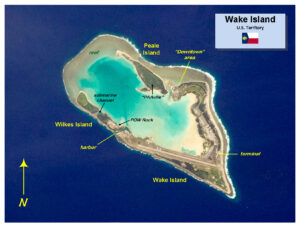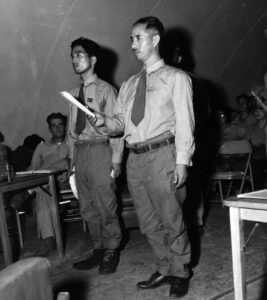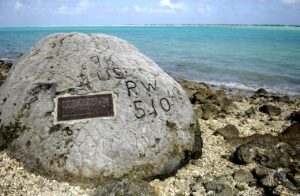
 The Battle of Wake Island was a significant conflict in the Pacific theater of World War II, occurring on Wake Island. The attack began simultaneously with the assault on Pearl Harbor’s naval and air bases in Hawaii on the morning of December 8, 1941 (December 7th in Hawaii) and concluded on December 23rd with the American forces capitulating to the Empire of Japan. The battle took place on the atoll comprising Wake Island and its smaller islets, Peale and Wilkes, involving air, land, and sea forces of the Japanese Empire and the United States, with a notable presence of Marines from both nations. The Japanese forces were formidable, and the majority of the surviving Americans were transported from the island to POW camps by the Japanese. Ninety-seven were left behind to be used as forced labor. The Allies’ response involved intermittent bombing of the island, but no further land invasions occurred. This was in line with a broader Allied strategy to isolate certain Japanese-occupied islands in the South Pacific, effectively leaving them to wither in isolation.
The Battle of Wake Island was a significant conflict in the Pacific theater of World War II, occurring on Wake Island. The attack began simultaneously with the assault on Pearl Harbor’s naval and air bases in Hawaii on the morning of December 8, 1941 (December 7th in Hawaii) and concluded on December 23rd with the American forces capitulating to the Empire of Japan. The battle took place on the atoll comprising Wake Island and its smaller islets, Peale and Wilkes, involving air, land, and sea forces of the Japanese Empire and the United States, with a notable presence of Marines from both nations. The Japanese forces were formidable, and the majority of the surviving Americans were transported from the island to POW camps by the Japanese. Ninety-seven were left behind to be used as forced labor. The Allies’ response involved intermittent bombing of the island, but no further land invasions occurred. This was in line with a broader Allied strategy to isolate certain Japanese-occupied islands in the South Pacific, effectively leaving them to wither in isolation.
On October 5, 1943, American naval aircraft from the USS Yorktown attacked Wake Island. On October 7, 1943, Rear Admiral Shigematsu Sakaibara, commander of the Japanese garrison on the island, orders the execution of a civilian accused of stealing, and 97 Americans POWs, claiming they were trying to make radio contact with US forces, and a civilian accused of stealing. Initially, the 97 POWs were detained to be used as forced labor. Anticipating an invasion, Sakaibara commanded their execution. They were led to the island’s northern end, blindfolded, and shot with a machine gun. One prisoner, whose name remains unknown, escaped and etched “98 US PW 5-10-43” into a large coral rock near the hastily dug mass grave. This American was later recaptured, and Sakaibara personally beheaded him with a katana. The etched message remains visible, marking a somber landmark on Wake Island to this day. The Wake Island Massacre was an outrage.
The Pacific war finally drew to a close starting in August 1945, and the Emperor of Japan announced the surrender to the Japanese people and the agreement was formally signed by September 2, 1945. On September 4, 1945, the remaining Japanese garrison surrendered to a detachment of United States Marines under the command of Brigadier General Lawson H. M. Sanderson, with the handover being officially conducted in a brief ceremony aboard the destroyer escort USS Levy. Earlier, the garrison received news that Imperial Japan’s defeat was imminent, so the mass grave was quickly exhumed, and the bones were moved to the US cemetery that had been established on Peacock Point after the invasion, with wooden crosses erected in preparation for the expected arrival of US forces. During the initial interrogations, the Japanese claimed that the remaining 98 Americans on the island were mostly killed by an American bombing raid, though some escaped and fought to the death after being cornered on the beach at the north end of Wake Island. Several Japanese officers in American custody committed suicide over the incident, leaving written statements that incriminated Sakaibara. Sakaibara and his subordinate, Lieutenant Commander Tachibana, were later sentenced 
 to death after conviction for this and other war crimes. Sakaibara was executed by hanging in Guam on June 19, 1947, while Tachibana’s sentence was commuted to life in prison. The remains of the murdered civilians were exhumed and reburied at Section G of the National Memorial Cemetery of the Pacific, which is commonly known as Punchbowl Crater, on Honolulu.
to death after conviction for this and other war crimes. Sakaibara was executed by hanging in Guam on June 19, 1947, while Tachibana’s sentence was commuted to life in prison. The remains of the murdered civilians were exhumed and reburied at Section G of the National Memorial Cemetery of the Pacific, which is commonly known as Punchbowl Crater, on Honolulu.


Leave a Reply